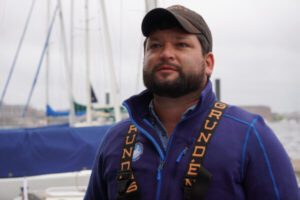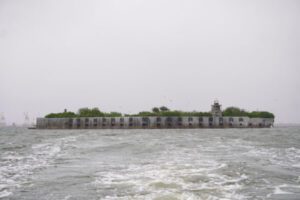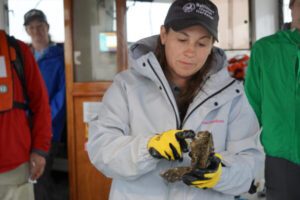by Christine Condon, Maryland Matters.
Ben Carver, a boat captain for the Chesapeake Bay Foundation, assumed the worst.
When Baltimore’s Francis Scott Key Bridge collapsed — killing six construction workers and sending thousands of tons of concrete and steel hurtling into the Patapsco River — Carver feared that the foundation’s nearby oyster reef would be smothered beneath the sediment and debris.
“I thought all of our little buddies out there would be dead,” said Carver, the foundation’s Baltimore Harbor Environmental Education Program captain.

He had last visited the reef, located beside historic Fort Carroll, the night before the tragedy, when he dredged up some oysters from the river bottom for a regular check-up. It would be about six months before he could return to inspect the reef, upon which 6 million oysters have been planted since 2008.
What he found surprised him. Healthy oyster after healthy oyster.
“These are resilient little things,” Carver said.
This month, the Bay Foundation began oyster planting at the fort for the first time since the bridge fell. In two boat trips to the site, schoolchildren and other volunteers have tossed an estimated 128,187 oysters overboard, to start their new lives in the Patapsco. The goal is to plant half a million oysters there this summer.
Last year, with maritime traffic limited in the Patapsco River channel during the typical planting season. oysters grown in and around the Baltimore Harbor that would have gone to Fort Carroll were planted in the Magothy River instead.
It was a hard decision, said Kellie Fiala, Maryland oyster restoration coordinator for the Bay Foundation. Staffers toyed with keeping the oysters in their dockside cages, and waiting to plant them at the fort, a manmade island fortress that never saw battle, but has become a sanctuary for cormorants, gulls and other seabirds. But keeping the oysters out of the reef during peak feeding season could have caused some to perish, Fiala said.
“People were very understanding, but we’re very excited to get oysters back in Baltimore, in the Patapsco River, where people are growing them,” she said.
Aboard the Snow Goose, the Bay Foundation’s educational vessel, volunteers start by counting the number of oysters, which appear as small dots on the rough grey shells, on a selection of shells. From there, they estimate the total number of mollusks that will be planted.
Once they reach Fort Carroll the process is simple: Volunteers grab a bright blue basket filled with oysters, and dump them over the side of the boat and into the murky depths.

But getting each oyster ready for release day is a bit more complicated.
It begins at the Bay Foundation’s Oyster Restoration Center in Shady Side, where oyster larvae are placed in tanks with recycled oyster shells, their preferred substrate. The setup mimics a natural process, which has become more difficult for baby oysters as the Chesapeake Bay’s oyster reefs dwindle.
“Imagine being fertilized, being born, and then having two weeks to find your forever home,” Fiala said. “That’s what they have to do.”
Once the baby oysters adhere to a shell, they’re known as spat. Afterwards, the spat-on-shell bound for Fort Carroll are moved to submerged cages around the Baltimore Harbor, where they are minded by volunteer “oyster gardeners” for their first year of life.
The cages help shelter the vulnerable young oysters, and keep them from sinking into the mud, serving the function of oyster reefs, which once rose above the surface of the Chesapeake in some places, snarling passing ships.
Domino Sugars in downtown Baltimore is a longtime “gardener,” and contributed tens of thousands of oysters to a planting this week, the second since the Key Bridge fell. Others came from the Seagirt Marine Terminal in Dundalk and Vane Brothers in South Baltimore, which are newer participants.
Frits de Goede, operations manager for Ports America Chesapeake, which operates Seagirt, said the group wants to up its game next year, in hopes of inching closer to Domino’s oyster number. Ports America grew 5,580 oysters this year, compared to Domino’s 21,060.
“We’re trying to work up to that,” de Goede said.
Gardeners periodically pull up the cages attached to their docks, and clean off any algae or debris, to ensure that the oysters get plenty of water flow.

Oysters are filter feeders, which means that they pull nutrients from the water column in order to survive and grow.
Therein lies their value to the Chesapeake Bay, which is beset by excess nutrients such as nitrogen and phosphorus, runoff from farm field fertilizer and sewage treatment plant discharges, among other sources. The excess nutrients spur the growth of algae, which essentially suck oxygen from the water as they die, creating hazardous anoxic conditions — “dead zones” — for crabs and fish.
But adding more oysters in the Chesapeake means more nutrients will be filtered out, strengthening ecosystems and further growing the natural oyster population.
Decimated by disease, harvesting and habitat loss, the bay’s oyster population has plummeted since the 1800s. While it once took Chesapeake oysters an estimated three days to a week to filter all the water in the bay, it now takes more than a year, Fiala said.
“We also couple that with the fact that there’s more people in the bay watershed than ever before having an impact. So, we need more oysters in the water than we have ever had,” Fiala said.
The strategy could be working. The Maryland Department of Natural Resources released a summary this week of its latest stock assessment for oysters in Maryland portions of the bay, which found that the population increased from 2.4 billion adult oysters in 2005 to 7.6 billion in 2024.
Back then, Maryland’s oyster population was just starting to recover from devastating bouts of disease, such as MSX and Dermo.
Mike Wilberg, a professor at the University of Maryland Center for Environmental Science who led the assessment, pointed to three reasons for the increasing trend in a news release from the department.

“The first one is that we have had some good spatsets,” he said. “The second one is that natural mortality rates, or particularly disease, hasn’t been as bad as it was in the 1980s and 1990s. And then the last one is that the department has maintained restrictions on harvesting that have allowed the oysters that are in some of these areas to continue to survive and reproduce.”
The stock assessment doesn’t include oyster sanctuaries like the ones at Fort Carroll, focusing instead on oyster bars that are open to harvesting. But large-scale restoration sites, planted by DNR and partner organizations, make up substantial portions of several harvest regions — and they’re likely strengthening the oyster harvest in their areas, Wilberg said in the news release.
“The three major restoration sanctuaries that are pretty much finished have all been really strong successes,” Wilberg said.
But the Bay Foundation believes there’s more to be done.
In a 2024 report entitled “Hope on the Half Shell,” the foundation pushed for Maryland and Virginia to establish sanctuaries in an additional 20 tributaries, ensure that 11 existing tributaries are maintained, and bolster the aquaculture industry, which grows oysters for consumption, by leasing more areas to proprietors.
There are two small sanctuaries on either side of Fort Carroll, Fiala said: a 2-acre plot and a 1-acre plot. In part to protect those two areas, the Bay Foundation is keeping a close eye on the effort to demolish the remainder of the Key Bridge and build its successor, said Gussie Maguire, Maryland staff scientist at the foundation.
“There are certain practices that can be put in place — and that we’re advocating for — to minimize the impacts of disturbing the sediment with the explosives and all that,” Maguire said. “Silt curtains on land, turbidity curtains in the water.”
In a September 2024 letter to the Maryland Department of the Environment, which is in charge of permitting for the new bridge site, the Bay Foundation highlighted the importance of the reefs.

While testing found the reefs in “relatively good” shape after the collapse and the subsequent salvage effort, “more extensive disturbances” could “impact these nearby reefs in the absence of proper precautions,” wrote Allison Colden, the Bay Foundation’s Maryland executive director.
“Nearly every weekday during the spring and fall school season, students sample the reefs at Fort Carroll to learn about the importance of oysters for water quality, habitat, and biodiversity,” Colden wrote. “The protection of these areas from disturbance and damage associated with bridge reconstruction will be critical.”
The Bay Foundation is also pushing for the rebuilt bridge to include new features such as upgraded filtration for stormwater, reducing the amount of rainwater that washes off the bridge’s roadway and directly into the Patapsco, carrying pollutants with it.
That could include the addition of a piping system with filters included, but it could also include the installation of rain gardens, known as bioswales, on either end of the new bridge, like at the Aurora Bridge in Washington State, the Bay Foundation said. Or the new bridge could host floating wetlands that could filter pollutants, like the ones installed at Baltimore’s National Aquarium nearby.
The new bridge will be wider than its predecessor, potentially increasing the discharge of pollutants “including trash, oil and grease residues, salt and brine during winter weather, and tire dust and other sediments,” and increasing the necessity of adequate stormwater treatment, Colden said.
In the meantime, the return of oyster plantings mere feet from the Key Bridge wreckage is a welcome symbol of the city’s toughness, Fiala said.
“Baltimore has a lot more behind it — a lot more resilience — than I think people give it credit for,” Fiala said.

YOU MAKE OUR WORK POSSIBLE.
Maryland Matters is part of States Newsroom, a nonprofit news network supported by grants and a coalition of donors as a 501c(3) public charity. Maryland Matters maintains editorial independence. Contact Editor Steve Crane for questions: editor@marylandmatters.org.
Come Aboard
"*" indicates required fields
